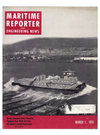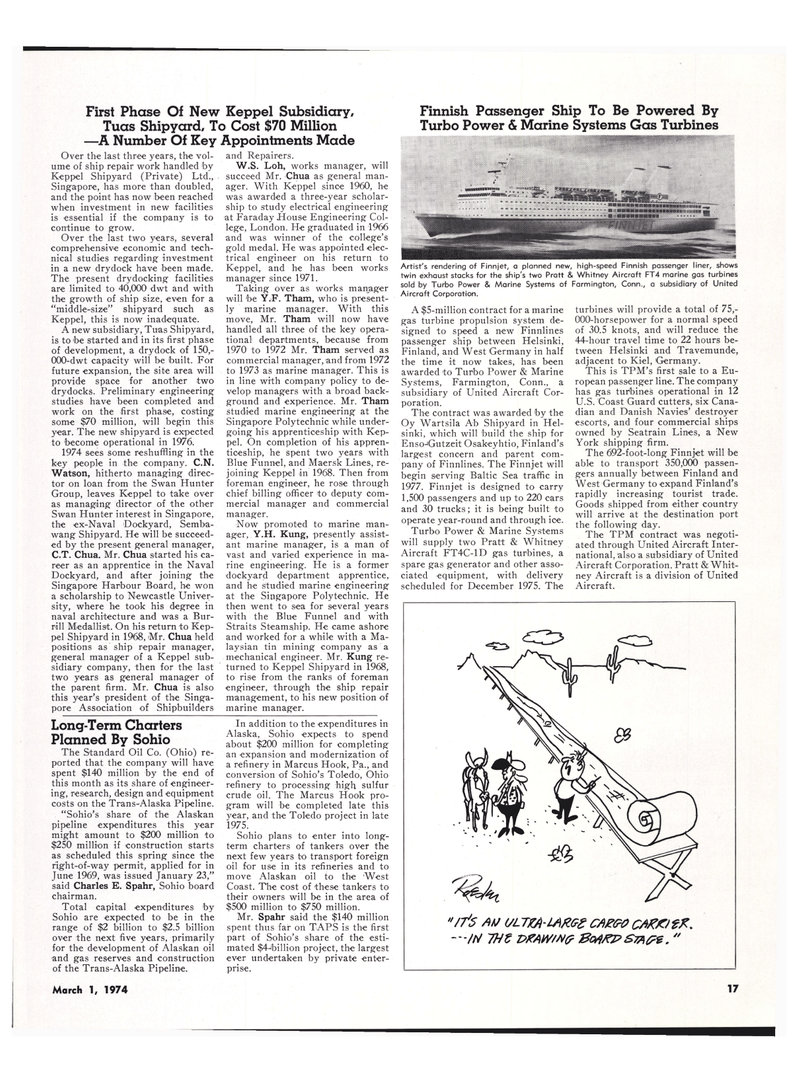
Page 13: of Maritime Reporter Magazine (March 1974)
Read this page in Pdf, Flash or Html5 edition of March 1974 Maritime Reporter Magazine
Long-Term Charters
Planned By Sohio
The Standard Oil Co. (Ohio) re- ported that the company will have spent $140 million by the end of this month as its share of engineer- ing, research, design and equipment costs on the Trans-Alaska Pipeline. "Sohio's share of the Alaskan pipeline expenditures this year might amount to $200 million to $250 million if construction starts as scheduled this spring since the right-of-way permit, applied for in
June 1969, was issued January 23," said Charles E. Spahr, Sohio board chairman.
Total capital expenditures by
Sohio are expected to be in the range of $2 billion to $2.5 billion over the next five years, primarily for the development of Alaskan oil and gas reserves and construction of the Trans-Alaska Pipeline.
March 1, 1974
In addition to the expenditures in
Alaska, Sohio expects to spend about $200 million for completing an expansion and modernization of a refinery in Marcus Hook, Pa., and conversion of Sohio's Toledo, Ohio refinery to processing high sulfur crude oil. The Marcus Hook pro- gram will be completed late this year, and the Toledo project in late 1975.
Sohio plans to enter into long- term charters of tankers over the next few years to transport foreign oil for use in its refineries and to move Alaskan oil to the 'West
Coast. The cost of these tankers to their owners will be in the area of $500 million to $750 million.
Mr. Spahr said the $140 million
spent thus far on TAPS is the first
part of Sohio's share of the esti-
mated $4- A $5-million contract for a marine
gas turbine propulsion system de-
signed to speed a new Finnlines
passenger ship between Helsinki,
Finland, and West Germany in half
the time it now takes, has been
awarded to Turbo Power & Marine
Systems, Farmington, Conn., a
subsidiary of United Aircraft Cor-
poration.
The contract was awarded 'by the
Oy Wartsila Ab Shipyard in Hel-
sinki, which will 'build the ship for
Enso-iGutzeit Osakeyhtio, Finland's
largest concern and parent com-
pany of Finnlines. The Finnjet will
begin serving Baltic Sea traffic in
1977. Finnjet is designed to carry
1,500 passengers and up to 220 cars
and 30 trucks; it is being built to
operate year-round and through ice.
Turbo Power & Marine Systems
will supply two Pratt & Whitney
Aircraft FT4C-1D gas turbines, a
spare gas generator and other asso-
ciated equipment, with delivery
scheduled for December 1975. The
turbines will provide a total of 75,-
000-horsepower for a normal speed
of 30.5 knots, and will reduce the
44-hour travel time to 22 hours be-
tween Helsinki and Travemunde,
adjacent to Kiel, 'Germany.
This is TPM's first sale to a Eu-
ropean passenger line. The company
has gas turbines operational in 12
U.S. Coast Guard cutters, six Cana-
dian and Danish Navies' destroyer
escorts, and four commercial ships
owned by Seatrain Lines, a New
York shipping firm.
The 692-foot-long Finnjet will be
able to transport 350,000 passen-
gers annually between Finland and
West Germany to expand Finland's
rapidly increasing tourist trade.
Goods shipped from either country
will arrive at the destination port
the following day.
The TPM contract was negoti-
ated through United Aircraft Inter-
national, also a subsidiary of United
Aircraft Corporation. Pratt & Whit-
ney Aircraft is a division of United
Aircraft.
17
First Phase Of New Keppel Subsidiary,
Tuas Shipyard, To Cost $70 Million
—A Number Of Key Appointments Made
Over the last three years, the vol-
ume of ship repair work handled 'by
Keppel Shipyard (Private) Ltd.,
Singapore, has more than doubled,
and the point has now been reached
when investment in new facilities
is essential if the company is to
continue to grow.
Over the last two years, several
comprehensive economic and tech-
nical studies regarding investment
in a new drydock have been made.
The present drydocking facilities
are limited to 40,000 dwt and with
the growth of ship size, even for a
"middle-size" shipyard such as
Keppel, this is now inadequate.
A new subsidiary, Tuas Shipyard,
is to 'be started and in its first phase
of development, a drydock of 150,-
000-dwt capacity will be Ibuilt. For
future expansion, the site area will
provide space for another two
drydocks. Preliminary engineering
studies have been completed and
work on the first phase, costing
some $70 million, will begin this
year. The new shipyard is expected
to 'become operational in 1976.
1974 sees some reshuffling in the
key people in the company. C.N.
Watson, hitherto managing direc-
tor on loan from the Swan Hunter
Group, leaves Keppel to take over
as managing director of the other
Swan Hunter interest in Singapore,
the ex-Naval Dockyard, Semba-
wang Shipyard. He will be succeed-
ed by the present general manager,
C.T. Chua. Mr. Chua started his ca-
reer as an apprentice in the Naval
Dockyard, and after joining the
Singapore Harbour Board, he won
a scholarship to Newcastle Univer-
sity, where he took his degree in
naval architecture and was a Bur-
rill Medallist. On his return to Kep-
pel Shipyard in 1968, Mr. Chua held
positions as ship repair manager,
general manager of a Keppel sub-
sidiary company, then for the last
two years as general manager of
the parent firm. Mr. Chua is also
this year's president of the Singa-
pore Association of Shipbuilders
and Repairers.
W.S. Loh, works manager, will
succeed Mr. Chua as general man-
ager. With Keppel since 1960, he
was awarded a three-year scholar-
ship to study electrical engineering
at Faraday House Engineering Col-
lege, London. He graduated in 1966
and was winner of the college's
gold medal. He was appointed elec-
trical engineer on his return to
Keppel, and he has been works
manager since 1971.
Taking over as works manager
will 'be Y.F. Tham, who is present-
ly marine manager. With this
move, Mr. Tham will now have
handled all three of the key opera-
tional1 departments, because from
1970 to 1972 Mr. Tham served as
commercial manager, and from 1972
to 1973 as marine manager. This is
in line with company policy to de-
velop managers with a broad back-
ground and experience. Mr. Tham
studied marine engineering at the
Singapore Polytechnic while under-
going his apprenticeship with Kep-
pel. On completion of his appren-
ticeship, he spent two years with
Blue Funnel, and Maersk Lines, re-
joining Keppel in 1968. Then from
foreman engineer, he rose through
chief billing officer to deputy com-
mercial manager and commercial
manager.
Now promoted to marine man-
ager, Y.H. Kung, presently assist-
ant marine manager, is a man of
vast and varied experience in ma-
rine engineering. He is a former
dockyard department apprentice,
and he studied marine engineering
at the Singapore Polytechnic. He
then went to sea for several years
with the Blue Funnel and with
Straits Steamship. He came ashore
and worked for a while with a Ma-
laysian tin mining company as a
mechanical engineer. Mr. Kung re-
turned to Keppel Shipyard in 1968,
to rise from the ranks of foreman
engineer, through the ship repair
management, to his new position of
marine manager.
«t?S AM ULTZA-IAKGZ CMM CAZftfK.
-7N 7HZ VZAW/Mfr S7A&2. "
Finnish Passenger Ship To Be Powered By
Turbo Power & Marine Systems Gas Turbines
Artist's rendering of Finnjet, a planned new, high-speed Finnish passenger liner, shows
twin exhaust stacks for the ship's two Pratt & Whitney Aircraft FT4 marine gas turbines
sold by Turbo Power & Marine Systems of Farmington, Conn., a subsidiary of United
Aircraft Corporation.

 12
12

 14
14
